






Welcome to the March edition of the magazine. I hope that you are all keeping well and are now looking forward to the Spring - it is going to be very tough for everyone with the current cost of living crisis and the state of the world that we live in. I don’t ever remember things been as bad as they are now - please continue to use the local businesses, shops, tradesmen and services that advertise in the magazine - it really does help our local economy, the local employment situation and ultimately the planet when you do.
We have an interesting and varied range of topics in this edition for your enjoyment ranging from a special Mens Health Feature that looks at Prostate Cancer, a feature on Vegan Holiday Destinations to Rebekah’s top Scalp Health Advice feature. In the House & Home feature we take a look at White Paint and also Decorating FOMO.



We also have our usual round up of all the New Books to read this month as well as a new feature on What To Watch. Roy Woodcock takes a look at the new 7 Seat Dacia in his Motoring Column


We have our regular Gardening column with Patrick White who takes a look at ReWilding. The Food & Drink section has two great recipes from Erkan at The Olive Tree: Porchetta Tonnata and a Pink Grapefruit Cheesecake for you to try at home. We also have our regular Wine Column with Roy Woodcock who relays the latest wine news and takes a look at the best wine buys currently available. As usual we finish off with Fiona Dwyer’s ‘food for thought’

Until next month take care and look after each other
Editor
Managing Director: Nic Gough.
Sales Director & Editor: Jane Gough.
Advertising Sales: Heather Mapplebeck.
Distribution Manager: Phil Hiscott.
Finance Manager: JP Kinnersley.
Designers: Mervyn King, Adam Jacobs.



Photography: Clash Pix.


Contributors: Fiona Dwyer, Roy Woodcock, Chris Warkup, Rebekah Robinson, Lee Johnson, Frances Lindley, Patrick White.
© Dalton Spire Limited 2023. All rights reserved. No part of this magazine may be used or reproduced without the written permission of the publisher. All information contained in this magazine is for information only and is as far as we are aware, correct at the time of going to press.
We cannot accept any responsibility for errors or inaccuracies in such information. Readers are advised to contact advertisers directly with regards to the price of products and/or services, referred to in this magazine.
With the continuing success of walking netball across the East Riding, a new session is being offered at East Riding Leisure Haltemprice, starting on Tuesdays from 7 March, from 11am-12noon. The cost will be £2.80 per session, and it is for those who have previously played netball or who would like to try something new, meet new friends, get a little fitter and have plenty of laughs along the way.
The walking netball sessions are a partnership between England Netball, East Riding Leisure Haltemprice and the council’s Health and Wellbeing team.

Councillor Mike Medini, portfolio holder for culture, leisure, libraries and customer services, said : “Walking netball is a slower version of the game with adapted rules – it is netball, but at a walking pace, and has been designed so that it is accessible to people of all ages, but these sessions are for ladies 50+. Come along and have a go!”
Sarah Johnson, sport and active communities officer, added: “The sessions will be led by staff initially; however, to sustain these sessions we are keen to recruit ex-players or umpires who would like to get involved with leading the sessions in the future.”
To take part, just come along to East Riding Leisure Haltemprice on Tuesdays in March at 10.45 am for an 11am start..

A new exhibition, ‘Remnants’, opens at the Beverley Guildhall on Wednesday, 1 March. The exhibition looks at fragments of buildings, and traces of industries and oddities around Beverley that have been abandoned, repurposed or are no longer in use today.


Kloskk Tyrer, who produced the exhibition, said: “We hardly notice some of the traces belonging to Beverley’s history which are hiding in plain sight today, but they tell the story of how people used to live and work in the town. These remains are everywhere – from a piece of wall belonging to a long-gone pub to strange marks on walls and mysterious lettering on kerbstones. If you know where to look, these remnants of the past are all around us.”
‘Remnants’ opens at the Beverley Guildhall on Wednesday, 1 March and runs until Friday, 30 June.
The Guildhall is in Register Square, off Cross Street, and is open on Wednesdays, 10am-1pm (to 30 April), then 10am-4pm (from 3 June), and 10am-4pm every Friday. Admission to the building is free.
Road improvements worth £3m are due to begin in the East Riding this spring and summer to help protect against potholes and other damage.
East Riding of Yorkshire Council is investing the money in its annual surface dressing programme, with 146 stretches of road in the area due to be
Around 13,000 tonnes of stone chipping will be laid on road surfaces between April and September, from ‘A roads’ to unclassified routes. Surface dressing is used as a quick and economical way of repairing, maintaining and extending the life of a road, and is carried out each year by the council’s own highways maintenance team.

Councillor Chris Matthews, the council’s portfolio holder for environment and climate change, said: “Surface dressing is always our first line of defence against potholes and other damage, and it plays an important part in protecting the East Riding’s roads for years to come.
“Thank you in advance to residents and motorists for their patience while we carry out this year’s scheme.”
Signs will be placed on all roads to be surface dressed a week before the work takes place.

With its almost magical ability to enhance feelings of space and light, white brings a wonderful sense of calmness to interiors. But how easy is it to make it work in your home? You’ll find the answer in this article by local painter/decorator and self-confessed interior design geek Lee Johnson. Packed with gorgeous inspiration and clever ideas, it’ll help you create unique, characterful rooms with the palest of shades...

Seasonal sprigs and wooden furniture add unfussy warmth and personality to a space, and team perfectly with the simplicity of pale decor. Make the most of the longer, lighter days of spring by throwing open the doors, and opt for portable bistro furnitureperfect for alfresco meals - with a cosy blanket on hand in case the temperature drops.
A great way to create pale schemes that are tactile and inviting is to embrace a mix of natural finishes. Organic, timeworn and weathered pieces always work well together. Try a combination of linens and wools with aged wooden accessories and items made from recycled glass - and keep patterns to a minimum to let the texture do the talking.
Continued page 8




You don’t need colour to create a gallery wall - keeping to a tight palette can often result in a more stylish, cohesive look. Use floating shelves to display artworks and prop pictures against the wall for a relaxed informal vibe. An added benefit of this arrangement is that you can easily change it whenever you fancy something different.
Pair white with black and it’s all about the drama. Pick a standout piece, such as a dresser or kitchen island, and work the other elements around it. Glossy marble and smart upholstered chairs will all add to the sleek glamour of the room.


Show off your favourite kitchen pieces on shelves - think vases, bottles, plates and even bakeware. Don’t be tempted to overfill: edit a selection of things you need every
day that also look good when not in use. Glass is always a winner for creating an uncluttered, spacious feel.
The bedroom should be a sanctuary where you unwind and recharge, and an understated palette is perfect for bringing a sense of serenity. And don’t forget about the light - if possible, position the bed where it maximises the morning’s rays for an uplifting start to your day.
Awkward corners or alcoves benefit from pared-back colour schemes. Maximise the space with built-in cabinetry or simple furniture, such as a dressing table, office desk or chest of drawers. that will also give you storage. Then add a few finishing touches such as mirrors, pictures and vases to make it look beautiful.


Continued page 10
16Flemingate,Beverley,HU170NRTel: 01482246779 Mob: 07821359325 Email:jack_priceltd@outlook.com












When it comes to creating our own homes not all the interior styles we like will work seamlessly together. So, when there are so many choices, how do we navigate our own way of using white?

Here are my top 10 tips to help you to find yours.
It’s important to work out what you need from each space, and to identify which design styles you love or are less keen on.
This will avoid any confusion. For me, all great home design projects have a strong ‘core essence’ that fluidly connects spaces and objects. The backdrop foundations begin with ideas for flooring, surfaces, hardware, paint and wallpaper, and these make the decorative decisions that follow much easier.
Tools such as Pinterest are helpful in seeking out ideas. It’s also
worthwhile having a physical mood-board that pulls together foundation ideas, which you can move around your home and view in situ. I often try to single out one image (no more than three) to sum up the core mix of materials I want to use.
Overlay your mood-board with ideas for decorative finishes, including furniture, curtain and upholstery fabrics, lighting and accessories. The way you choose to accessorise and dress your spaces will make your home feel unique.
Once you’ve decided on your key materials, order in samples. Layer them together to check they work in reality – they can be very different from how you imagined.
Mine is Slate from Paint & Paper Library. We’ve used it throughout our Beverley home - on walls, doors, cornices, ceilings and window frames. love the quiet, harmonious foundation it’s created.
There are so many whites available and they look so different from home to home. Always test colours on white paper, never directly on the walls, and paint the sample edge to edge, to avoid reflections that distort the finish.
Quality, comfort and practicality are key considerations when choosing furniture, so think about lifestyle needs to determine what is important to you.
Curating the finishing touches is transformative. Simple additions, such as an artful display of ceramics, well-placed textiles and layered styling on beds, shelves and tables, will heighten the visual appeal.

If you’re designing a whole house at once, consider rooms together to ensure the spaces flow and connect. If you’re at the start of a longer, slower project, don’t compromise on choices. It’s worth getting your core ideas clear at the outset to help you achieve a cohesive finish.
Creating a lived-in feel will help ramp up the cosy factor. Soft layered linen and blankets, along with armchairs and rugs, will help you achieve this.
1. Play with proportion by curating handcrafted finds on mantel pieces and window sills - keeping the tallest item in the middle and working outwards to help draw the eye across the display.
2. Add impact with clean, sculptural shapes and keep the look interesting by including a few unexpected pieces, such as woven lights or bleached wood furniture.

















indecision. And it’s not like it’s cured by simply getting a grip and picking something. It’s the start of an entire state of Fear of Missing Out, the constant wondering with every slap of paint on a wall or fabric length ordered whether this one is really The One. In short, a total joy sucker. But also, let’s return to that part about getting a grip. Because there are enough real-world worries to induce 4am panic attacks and paint choices are probably a more manageable element of my simmering insanity.
I grew up in the time of terrestrial TV. A simpler age. Back when a brief flick through the TV listings would decide which of the four channels on offer at any given point would be the one to turn on. There was no real opportunity for indecision. No spending thirty minutes of your precious time scrolling through Netflix’s endless options. No wondering if this is what you really want to watch or if you’re in the mood for something else entirely.



You know where I’m going with this… Too Much Choice Syndrome: a very modern condition. Inarguably on the lite end of that exponential list of First World Anxieties, but pervasive enough that it’s crept into innumerable aspects of our lives; everything from TV watching and dinner making to, yes, this is where I’m going, decorating. Because surely, I’m not the only one who suffers from Interiors Anxiety? Another side-effect of this social media driven age. Too much time spent down a Pinterest rabbit hole. Too long scrolling through perfect Instagram images of wildly different interiors – all lovely, all the stuff of inspiration. Altogether too overwhelming.
Social media has long been a recipe for envy and discontentment. It is also the main cause of my crippling
First, I focus on the bigger picture. Not in a metaphysical sense (we can apply the ‘nothing really matters’ philosophy to pretty much anything in life, so let’s not bother). Rather in the sense of thinking about the overall feel of a room as opposed to its individual components. If you can try to define your scheme/style/look in, say, three to five words, it puts greater emphasis on the overall outcome and less on every little detail you’re deliberating over. This approach has, in turn, made me a committed mood-boarder. For me, this is a fairly crude and uncomplicated process of screengrabbing – or, if it already exists in situ, photographing – anything I’ve either shortlisted or am already working with and dragging the images into one document to see how they all work together.
There are various apps you can download, the free version of Canva does the job – even a Word doc will suffice. It’s the quickest way to weed out weak links and to choose between competing soft furnishings, paint colours or flooring choices. More than anything, it’s crucial to draw the line between inspiration and comparison. There’s a point when you have to stop looking at welltaken images of rooms created by professional designers or those on huge budgets or carefully staged corners crafted for ‘likes’ not living. It’s not just online. Confession: the majority of my house is painted in colours from one well-known paint brand not because I think it’s
necessarily better than others but because I already have enough trouble deciding between their 37 shades of not-quite-white. Choosing between numerous different hues from numerous different other brands may well send me catatonic.
Finally, the reality is that you are going to make mistakes. They sting when it’s costly, whether in time or cash. And annoyingly, they contribute to the anxiety. Redoing our bedroom has been fraught with second-guessing and doubt because our last big project, a kitchen makeover, never quite worked the way I envisioned. In my defence, this was in the days before my mood-boarding obsession and I made foolish decisions like putting down some bargain flooring after we’d already painted cupboards
and walls. No matter how much tinkering I do, it’s never quite come together. Interior designers encourage you to be enthusiastic returners – buy it, try it, and if it doesn’t work, return it.
Use a mood-board to get the foundations of floors, walls and major furniture pieces right, and then accept nearly everything else is trial and error. Yes, it takes time, but the best things often do. You’re not in an episode of Changing Rooms. And the fact we now have 24-hour access to much better interiors’ inspiration than just Lawrence L-B’s Baroquethemed bedroom makeover is something we should all be thankful to social media for.
So, use it for what it is. Just don’t scroll for too long…
With so much interiors’ inspiration out there, it can sometimes feel like there’s just too much choice. So, stop scrolling and make a decision… it just might be the right one!












Erkan

Sahindalbusiness owner at the Olive Tree on Lincoln Way, Beverley - and accomplished chef shares his recipe for Porchetta Tonnata and Pink Grapefruit Cheesecake.

SERVES 2 AS A STARTER | PREP 40 MINS PLUS 24 HRS BRINING | COOK 3 HRS PLUS COOLING | EASY |
INGREDIENTS
500g chunk of pork belly, skin and bones removed (ask your butcher to do this)
Crispy fried capers (fry a couple of spoonfuls of capers in a little oil until crisp)
Extra-virgin olive oil, for dressing
A handful of mustard cress
TONNATA PASTE
80g tinned tuna, reserving any oil 10g capers, plus 2 tsp of brine from the jar
75g anchovies
TONNATA SAUCE
2 egg yolks
100-200ml oil made up of any tuna oil from the can and olive oil
A splash of chardonnay vinegar
METHOD
1 Submerge the pork belly in a 10% brine (20g of salt dissolved into 200ml of water) for 24 hours – this helps to flavour the meat and keep
it pink. This is not essential – if you are short on time, an overnight salting is fine (sprinkle with salt, put in a container and keep in the fridge).
2 Take the pork out of the brine (or salt), wash under cold water for 5 mins and dry well. Roll the belly and tie at intervals with butcher’s string. Vacuum-pack the meat or seal it tightly in a bag with as much air as possible squeezed out. Steam at 80C for 4 hrs. Alternatively, if you don’t have a steamer, you can also poach the pork for 2-3 hrs until tender, or cook, tightly wrapped in foil, on a very low setting in the oven for 2-3 hrs. Once cooked, cool quickly. Once cold, slice the porchetta as thinly as you can with a sharp knife – you will need 12 slices.
3 To make the paste for the sauce, blitz all the ingredients using a hand blender until smooth, then push through a fine sieve.
4 For the sauce, blitz the paste and egg yolk together on a medium speed, slowly adding 100ml of the oil until it is emulsified and thick. Add more oil if you need to. Adjust the seasoning with chardonnay vinegar to taste. If you chill the dressing it will thicken more.
5 To serve, put a generous amount of tonnata sauce in the bottom of two shallow bowls. Put six slices of pork on top of the sauce, adding some additional sauce on top. Finish with the crispy fried capers, olive oil and some peppery mustard cress.
SERVES 8 | PREP 30 MINS PLUS CHILLING | COOK 40 MINS | EASY
INGREDIENTS
PASTRY
150g plain flour
75g salted butter, cold, cubed
50g icing sugar
1 egg yolk
CHEESECAKE FILLING
100g mascarpone
100g crème fraîche
2 tbsp freshly squeezed pink grapefruit juice
Zest of 1/2 a grapefruit
2 tbsp icing sugar
60ml double cream
GRAPEFRUIT JELLY
2 gelatine leaves
130ml freshly squeezed pink grapefruit juice
50g caster sugar
METHOD
1 To make the pastry, put the flour, butter and icing sugar into the bowl of a food processor. Pulse very briefly until the mixture resembles rough breadcrumbs. Add the egg yolk plus 2 tbsp of icecold water and pulse until it starts to form a rough ball of dough. If too dry, add another tbsp of icecold water.
Transfer to a worksurface to bring together, handling as little as possible. Flatten it out into a disc, wrap in baking paper, then chill for at least 30 mins.
2 Remove the dough from the fridge and keep it on the baking paper. Lightly flour a work surface and roll out the pastry to about 2mm thickness. Use a rolling pin
to gently roll up the pastry and lay into a 22cm-wide, 3cm deep, straight-sided, loose-bottomed tart tin. Press the pastry gently into the tin, letting any excess pastry overhang. Chill for 1 hr.
3 Heat the oven to 180C/160C fan/ gas 4. Remove the tin from the fridge and prick the base with a fork several times. Fill with baking paper and cover the base with baking beans. Bake for 15 mins, then remove the baking beans and baking paper. Bake for another 20 mins or until deeply golden brown all over. Leave to cool completely.
4 Whisk together the mascarpone, crème fraîche, grapefruit juice, zest and icing sugar in a large bowl. In a separate bowl, whisk the cream until soft peaks form, being careful not to overwhip. Fold the cream into the mascarpone mixture until it forms a smooth, thick mixture. Transfer into the tart crust, using a small offset spatula or similar to evenly smooth the filling. Chill.
5 To make the jelly layer, put the gelatine leaves in a small bowl of cold water, making sure they are fully submerged. Put 50ml of the grapefruit juice into a small pan along with the sugar. Stir over a low heat for 1-2 mins or until the sugar has dissolved – the mixture should be hot but not boiling.
6 Squeeze the gelatine leaves to remove any excess water. Remove the pan from the heat and stir in the gelatine along with the remaining grapefruit juice. Strain through a sieve and leave to cool slightly before pouring onto the surface of the tart and chilling for 2 hrs or until set.

Some advice for pairing food and wine can be overly strict. The truth is, you can eat pretty much whatever you want while drinking whichever wine you choose. I enjoyed a rare steak with a couple of glasses of an oaked Chardonnay recently and it was, I have to say, something that worked really well..
Which proves the point - a red will be the go-to choice for most people, I guess, when it comes to pairing wine with steak, but at the end of the day it’s what works for you.
Yes, red wines do work well with red meats (and more to come about that, with examples, below). It’s the tannins (the dry feeling you get in your mouth when you’re drinking red wine or even a cup of tea) that work well against the robust flavours and fattiness of a great cut of steak. But which red?
If we really want to refine this particular steak/red wine “match” we need to consider about the cut of meat you’re going for. Sirloin, flank and bavette are examples of leaner steaks while ribeye and rump are more powerful ones.
Sauce matters too. If you’re having something spicy, you’ll want to tone down the power in the wine so it’s not all too much in your mouth. If you’ve got some creamy
peppercorn sauce going on, you might want a little more acid in your wine to cut through all that richness.
Malbec and Cabernet Sauvignon, particularly Malbecs from Argentina, the home of steak, certainly work well. Malbecs generally taste like lush dark fruits and have plenty of those handy tannins, making them a great match for meaty dishes.
Cabernet Sauvignons, particularly those from California, are super powerful wines that go well with steak cuts like Ribeye or other bone-in types. They too have lots of nice dark fruits and tannins going on.
If you’ve got a leaner cut, like a sirloin, you could try a Syrah from France, a South American Cinsault, Italian Montepulciano d’Abruzzo or Spanish Tempranillo. These wines are usually light to medium bodied (you don’t need as much body if your steak isn’t as meaty) and have nice acidity. Plus, they’re super versatile, so if you’ve got half a bottle leftover you could have it with a bowl of ragu or sausage casserole.
And then, of course, there’s the Chardonnay option! And having said that, here’s a few more food and wine suggestions you might want to ignore . . .
Pinot Noir: Pair with earthy flavours: Recipes made with earthy ingredients like mushrooms and


Tilimuqui Fairtrade Organic Malbec

Price: £7.99 (was £11.99)
Where: Waitrose
When: Current offer
Why: Silver medal winner in the International Wince Challenge of 2020. Elegant, intensely rich red wine with silky smooth black fruit flavours on the palate, supple tannins and a spicy complex finish. A perfect choice for special get-togethers, parties, barbecues or a cosy night in. Best enjoyed with a juicy steak and all other types of grilled red meat.
El Esteco Malbec
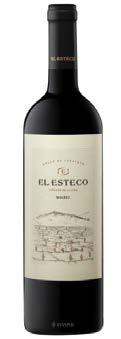
Price: £11 (was £13)
Where: Co-op
When: Now, until March 14
Why: A well balanced, spicy and subtly smoky Argentinian Malbec. A Fairtrade wine that’s rich, with soft and fruity aromas that lead on to a palate of plum jam, raisins, tobacco, chocolate, vanilla and toasted notes. Perfect with beef whether grilled, roasted, or barbecued.
lentils taste great with reds like Pinot Noir, which is light-bodied but full of savoury depth. Pinot is also often delicious alongside salmon, proving that red wine and fish can go together brilliantly.
Sauvignon Blanc: Goes with tart dressings and sauces: Tangy foods — like scallops with a grapefruitonion salad — won’t overwhelm zippy wines like Sauvignon Blanc, Vinho Verde from Portugal, and Verdejo from Spain. Sauvignon Blanc also works well alongside vinaigrette, roasted or sautéed fish, and goat’s cheese.
Dry Rosé: For rich, cheesy dishes: Some cheeses go better with white wine and some sing alongside red. Almost all, however, pair well with dry rosé, which has the acidity of white wine and the fruit character of red. Rosé also works well with grilled fish, fresh salad, and even a big plate of charcuterie.
Pinot Grigio: Pairs with light fish dishes: Light seafood dishes seem to take on more flavour when matched with equally delicate white wines, such as Pinot Grigio from Italy, Chablis from France, and Vinho Verde from Portugal.
Malbec: Holds up to sweet-spicy barbecue sauces: Malbec, Shiraz, and Côtes-du-Rhône are bold enough to drink alongside foods brushed with heavily spiced barbecue sauces — just be careful that the sauce isn’t too sugarysweet, which can throw off the wine’s fruit.
Syrah: For highly spiced dishes: When a meat is heavily seasoned, look for a red wine with lots of spicy notes. Syrah or Cabernet Franc are good choices. But be careful with spice heat, however: For hot dishes
like those, try to avoid high-alcohol wines, which will amplify the sizzle.
Off-Dry Riesling:
Pairs with sweet and spicy dishes: The slight sweetness of many Rieslings, Gewürztraminers, and Vouvrays helps tame the heat of spicy dishes and goes toe-to-toe with the lift of more aromatic ingredients. A spicy green salad is a delicious partner for any of those wines. Zinfandel: For Pâtés, mousses, and terrines: If you can apply the same adjectives to a wine and a dish, pairing them will often work. For instance, the words “rustic,” “savoury,” or “rich” are often used to describe Zinfandel, Italy’s Nero d’Avola, and Spain’s Monastrell, as well as a creamy liver mousse. Spice and fruit-driven Zinfandel also has a natural affinity for barbecued or sauce-slathered meats.
Champagne: Perfect with anything salty: Many dry sparkling wines, such as brut Champagne and Spanish Cava, actually have a faint touch of fruity sweetness. This makes them extra-refreshing when served with salty foods. They also cut through the richness and oil of fried dishes. Great with fish and chips!
Moscato d’Asti: Loves fruit desserts: Sweet sparkling wines such as Moscato d’Asti and demi-sec Champagne help emphasise the fruit in the dessert, rather than the sugar. It’s also delicious alongside a simple summer fruit salad, or even splashed into it.
Don David Blend of Terroirs Malbec


Price: £8.25 (was £9.25)
Where: Co-op
When: Now, until March 14
Why: From Argentina’s Calchaqui Valley wine region, this is a blend of two Malbecs from different high altitudes. One brings the fruit concentration while the other adds structure, texture and backbone. Oak is noticeable but not intrusive, sweet vanilla, cocoa and a kind of earthy, meatiness in the background, which was nice.
Morrisons The Best Toscana
Price: £8 (was £10)
Where: Morrisons
When: Currently on offer.
Why: Italian red that actually looks quite inky in colour with a full mellow taste of ripe, black fruit. The softness of this rich wine makes it the perfect drop to sip alongside bitterly dark chocolate. But it’s also great with Sunday roast or any Italian dish.
Organic food presents numerous benefits, and if you have concerns about the environment, going organic may be the right choice for you. The farming methods associated with organic food production can be helpful for improving soil health, as well as encouraging wildlife and biodiversity.

From a health perspective, conventional produce may contain higher levels of pesticides and antibiotics, depending on farming practices. Some studies suggest that organic produce may supply more micronutrients, such as vitamin C, magnesium and phosphorus, while organic meat and milk may contain as much as 50% more nutrients, including omega-3 fatty acids.

However, organic food can be pricier. It’s still more beneficial to consume non-organic fruit and veg in order to achieve your five-a-day than to go without.

Whether you’re dairy-free or forgoing cow’s milk you don’t have to miss out on flavour or the nutritional benefits.
Try these healthy substitutes:
Soya milk High in protein
Almond milk Low-calorie

Oat milk High in fibre
Hemp milk Source of plant-based omega-3 fatty acids
Pea milk Soya-free and high in protein
Coconut milk Nut-free and extracreamy
Rice milk Best for those with allergies
Flax milk Rich in healthy plant fats
Sheep’s milk Easy to digest
Lacto-free milk For lacto intolerance
Phonebookingsonly:01482881622(depositrequired)





Bookingearlytoavoiddisappointment




recommendations from our readers...
The Shopgirl’s Forbidden Love
 by Jenni Fletcher Belles
by Jenni Fletcher Belles
Biscuit Shop in Bath is more like a home than a place of work for manager, Nancy MacQueen. The shared attraction between her and James Redbourne, the handsome, kind-hearted owner of a nearby store, has been simmering for years, but she’s refused to trust his feelings for her. After all, they’re not remotely in the same social class and she values her independence. Until, one day, Nancy can no longer deny her love - only to find he’s become engaged to someone else! Part #4 in Mills & Boon’s Regency Belles of Bath historical romance series.
Playing For Love is a modern take on You’ve Got Mail. Sam (Samadhi) and Luke work in the same office. They both have secret identities as computer gamers. She’s in love with him in the video game world; he’s in love with her in the real world. When Sam’s not working on her fledgling business, she spends her time secretly video-gaming. Her crush is famous gamer Blaze, and she’s thrilled when she’s teamed up with him in a virtual tournament.

But what Sam doesn’t know is that Blaze is the alter ego of Luke, her shy colleague – and he has a secret crush too.
Luke has a crush on Sam. Sam has a crush on Blaze. How will this game of love play out?
The clever and moving Maybe Next Time will resonate with any woman who struggles with “the juggle” of having it all. Emma, a successful literary agent, is having the worst day of her life. Work, kids, the dog, the PTA and especially her husband Dan are adding to her stress but when the day ends in tragedy, Emma is destroyed. Then she wakes up the next morning and the same day starts again and again and again until Emma can figure out where she’s gone wrong.
Life for a Lady
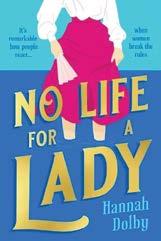 by Hannah Dolby
by Hannah Dolby
Twenty-eight year old Violet Hamilton is determined not to marry though surely no woman in 1896 actually wants to be a spinster? Violet is more interested in finding out why her mother disappeared ten years before. But when she engages the services of a detective, she uncovers all manner of secrets and scandals in respectable Hastings and will put her own reputation at risk to find the truth. A giddy romp through a Victorian seaside town and the lives of ladies who choose not to be married. I loved it..
Dirty Laundry
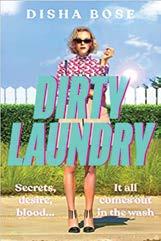 by Disha Bose
by Disha Bose
In an affluent village in Cork, social media influencer Ciara is the queen bee of the local mums, while her faithful acolyte Mishti is stuck in an unhappy arranged marriage and homesick for India and the man she left behind. Then there’s unconventional, uncompromising Lauren who’s not afraid to make enemies. When one of the women is found dead, a peek behind the Instagram filters and bifold doors
reveals any number of likely suspects in this thought-provoking, pacy thriller..
MacBethad
by Isabelle SchulerIt feels as if every other book currently being published is a feminist retelling of a classic myth but Lady MacBethad, the origin story of Lady MacBeth is one not to be missed. MacBeth was loosely based on real events in medieval Scotland and Lady Macbethad is a prequel to the play, which centres on the complex, complicated, ambitious character of Gruoch, a pagan princess destined to be queen by her marriage to MacBeth. Exquisitely written, this poetic novel and its unforgettable heroine seems a shooin for this year’s Women’s Prize.
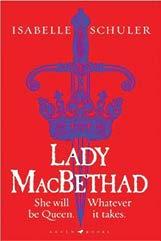
Murder Under The Tuscan Sun
 by Rachel Rhys
by Rachel Rhys
Middle-aged widow Constance
Bowen leaves dreary 1920’s England for a Tuscan castle as companion to stroke victim William North. Also in residence is William’s niece, the beautiful, flighty Evelyn, her handsome second husband Roberto, a rising star in the Fascist party and her lonely little daughter Nora. The idyllic surroundings soon give way to something more sinister. William relapses, things go missing and at night Connie is tormented by the sound of a child crying. Is she going mad or does someone mean her harm? A deliciously atmospheric and menacing thriller that nods to Daphne Du Maurier and Patricia Highsmith.
The Close by Jane Casey
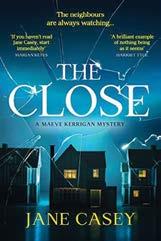
Jane Casey is the crime writers’ crime writer and fans of her DS Maeve Kerrigan police procedural series are legion and loyal. Which brings us to The Close, the tenth book in the series where Maeve and DI Josh Derwent go undercover
as a couple who move into a suburban cul de sac to sniff out a ne’er do well. But then things start to get murder-y and Maeve may find herself as a target rather than a deterrent. Come for the compulsive, tightly plotted whodunit and stay for the sizzling sexual tension between Maeve and Josh. Scorchio!
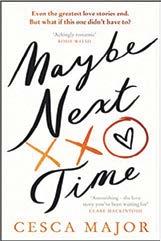
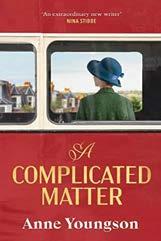
by
Anne YoungsonAn engrossing story set during the Second World War and following Rose Dunbar, transported from her native Gibraltar to life as a refugee in a formerly grand hotel in Kensington. Rose is very much a stranger in a strange land as the bombs fall in this note perfect period novel. I wouldn’t have been at all surprised if it was a forgotten classic republished by Persephone or Virago Modern Classics.
Everything by Kara Gnodde
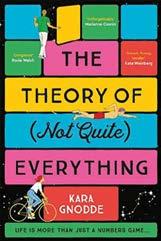
After the death of both of their parents, it falls to Mimi to put her adult life on hold to tend to her maths genius older brother, Art. But when Mimi decides to centre herself and her heart first, Art persuades her to allow him to manage her love life according to strict mathematical logic. But love doesn’t work that way and when Frank comes into Mimi’s life, his presence threatens to destroy the siblings’ relationship and expose a shocking family secret. This was a slow-burn read for me but by the halfway point I was thoroughly invested in both Art and Mimi and emotionally devastated by the twists that lay ahead. Debut author, Kara Gnodde is one to watch.
All the books in this feature are available to purchase now at The Beverley Bookshop, 19 Butcher Row, Beverley HU17 0AA.
Please buy your books locally and support your local bookshops and the local economy - it really does make a difference!
If you’re after a new read, we’ve rounded up the best books out there –from highly anticipated debuts to thrilling sequels. Plus, we’ve included a handful of top reader












WHAT IS PROSTATE CANCER?
Prostate cancer is the most common cancer in men, with one in eight men being diagnosed in their lifetime. It usually progresses very slowly; men can sometimes live for decades without noticing any symptoms. Prostate cancer starts in the walnut-sized prostate gland, which is part of the male reproductive system located between the penis and the bladder, surrounding the urethra.
WHAT ARE THE SYMPTOMS?
Symptoms of prostate cancer do not usually appear until the prostate becomes large enough to affect the tube that carries urine from the bladder out of the penis, known as the urethra. When this happens, you might start to notice things such as an increased need to pee, straining while you pee or a feeling that your bladder has not fully emptied. It’s important to understand that these symptoms do not always mean you have prostate cancer, but they also shouldn’t be ignored.
WHAT CAUSES PROSTATE CANCER?

While the exact cause is unknown, there are certain factors that can increase your risk. As you age, your chances of developing prostate cancer are higher, with most cases developing in men aged 50 or older. It can be more common in black men and less common among Asian men. A family history of prostate cancer can also increase
the risk slightly, particularly for men whose father or brother have been affected.
HOW IS PROSTATE CANCER TESTED?
There is no single test to diagnose prostate cancer. The most-used tests are blood tests known as a prostate-specific antigen (PSA) test, a physical examination of your prostate, an MRI scan or a biopsy. A prostate-specific antigen blood test measures the level of PSA and may help detect early prostate cancer. If you do have a raised PSA level, you might be offered an MRI scan of the prostate to help decide if you need further tests and treatment, as results from a PSA test can be unreliable and raised PSA levels can be caused by noncancerous conditions.
Not all prostate cancer cases will need treatment, especially if it’s at an early stage and not causing symptoms. Some cases of prostate cancer can be cured if treated in early stages. Treatment includes surgically removing the prostate, or radiotherapy, sometimes alongside hormone therapy.
If you or a loved one is affected by cancer and you would like further information or support, you can speak to a Boots Macmillan Information Pharmacist (BMIPs) in most Boots pharmacies across the UK and online. The specially trained BMIPs can offer free information, support and advice to cancer patients, as well as to their friends and family. You can also contact Macmillan’s free helpline on 0808 808 0000, seven days a week from 8am–8pm.
Regular sex is good for your heart, according to new research in the Archives of Sexual Behavior. Most men typically burn around 100 calories during sex, with heart rates climbing to around 170 beats per minute at the more vigorous end. These heart-boosting benefits may explain why men who have sex at least twice a week have a 45% lower risk of heart attacks, according to the American Journal of Cardiology.
Regular meditation can improve your gut health, according to new research in the journal General Psychiatry. A team of researchers found that meditating Tibetan monks have a much healthier gut microbiome – the friendly microbes in your gut which break down food – which is linked to a stronger immune system and a reduced risk of anxiety, depression and heart disease. This links to the so-called ‘gut-brain axis’ – the two-way connection that links the health of the brain with the health of the gut – and maintaining a stress-free mind through regular meditation appears to work wonders for it.
1. AVOID STILLNESS
Even if you sit in an upright position often viewed as ‘perfect’, you will develop aches and pains if you stay there long enough. Our bodies are designed to move, so change your posture regularly. Walk around your office or home regularly, and try hourly thoracic rotations, shoulder rolls and head turns. Setting yourself email or phone reminders can be useful.
2. STAY ACTIVE
There is evidence that doing 150 minutes of moderate exercise a week can counteract the effects of a sedentary working day. Any sport or activity that takes your spine through a large range of movement is great for posture.
3. MAINTAIN STRENGTH
Strength work can improve your bone health and make you more resilient to different postures. Aim for at least two resistance training sessions a week – and incorporate bent-over rows and reverse flyes, which strengthen the muscles between your shoulder blades.
Could be added to your lifespan if you’re married, according to the journal Population Health. Studies suggest married men tend to eat healthier, are less likely to drink or smoke, and less likely to suffer from inflammation and stress (some married men may disagree).
Sex drive taken a nosedive? It’s only natural for libido to dwindle with age, as levels of testosterone – men’s main sex hormone – start to dip. Throw in hectic work schedules, kids, relationship problems and general day-today stress, and it’s little wonder between-the-sheets motivation takes a knock. Luckily, alongside plenty of exercise and less stress, the world of food can provide a libido lift. So take the following ingredients and get ready to cook up a storm…

It’s the theobromine found in chocolate that provides its libidoboosting benefits. This bittertasting alkaloid works in a similar way to caffeine, with mood-lifting qualities to boot. It also contains phenethylamine, which adds to the release of endorphins. Our bodies break down this molecule [phenethylamine] very quickly, meaning it doesn’t have a longterm effect. However, in the shortterm it increases the release of serotonin and dopamine.”
According to one study,3 the ‘pistachio diet’ is effective at improving blood cholesterol and stimulating blood flow. Both of these benefits have been linked to potentially helping erectile dysfunction issues. Add pistachios to your Friday-night curry or snack on a handful mid-afternoon.
Add a spoon of the sweet stuff to your porridge. Research has found honey can ‘improve libido, erectile function, spermatogenesis, epididymal sperm count and normal sperm percentage’s – an impressive set of bedroom benefits.
As you get older, your chances of developing prostate cancer are higher, with most cases developing in men aged 50 or older





the Branch Davidians and federal law enforcement in an epic drama about God and guns in America.
Luther: The Fallen Sun, Netflix Luther: The Fallen Sun is the longawaited and epic continuation of the award-winning television saga. A gruesome serial killer is terrorising London while brilliant but disgraced detective John Luther (Idris Elba) sits behind bars. Haunted by his failure to capture the cyber psychopath who now taunts him, Luther decides to break out of prison to finish the job by any means necessary. The film also stars Cynthia Erivo, Andy Serkis and Dermot Crowley, who returns as DCI Martin Schenk.

Boston Strangler, Disney+ Loretta McLaughlin (Keira Knightley), a reporter for the Record-American newspaper, becomes the first journalist to connect the Boston Strangler murders. As the mysterious killer claims more and more victims, Loretta attempts to continue her investigation alongside colleague and confidante Jean Cole (Carrie Coon), yet the duo finds themselves stymied by the rampant sexism of the era. Nevertheless, McLaughlin and Cole bravely pursue the story at great personal risk, putting their own lives on the line in their quest to uncover the truth.
When private detective Philip Marlowe (Liam Neeson) is hired to find the ex-lover of a glamorous heiress (Diane Kruger), it looks an open and shut case, but Marlowe soon finds himself in the underbelly of Hollywood, unwittingly drawn into the crossfire of a legendary Hollywood actress (Jessica Lange). For Neeson’s 100th film, the ensemble cast includes Adewale Akinnuoye-Agbaje (His Dark Materials), Danny Huston (Yellowstone), Alan Cumming (GoldenEye) and Colm Meaney (Gangs of London).

by two charismatic lead singers –Daisy Jones (Riley Keough) and Billy Dunne (Sam Claflin) – the band had risen from obscurity to fame. And then, after a sold-out show at Chicago’s Soldier Field, they called it quits. Now, decades later, the band members finally agree to reveal the truth. This is the story of how an iconic band imploded at the height of its powers.
The Power is an emotionally driven global thriller from the team behind Chernobyl, based on British author Naomi Alderman’s awardwinning novel. The Power is our world, but for one twist of nature: suddenly, and without warning, teenage girls develop the power to electrocute people at will. The series features a cast of characters from London to Seattle, Nigeria to Eastern Europe, as the Power evolves from a tingle in teenagers’ collarbones to a complete reversal of the power balance of the world. The series stars Toni Collette.
Logan Roy (Brian Cox) and his four grown children, Kendall (Jeremy Strong), Siobhan (Sarah Snook), Roman (Kieran Culkin) and Connor (Alan Ruck). The sale of media conglomerate Waystar Royco to tech visionary Lukas Matsson (Alexander Skarsgård) moves ever closer. The prospect of this seismic deal provokes existential angst and familial division among the Roys as they anticipate what their lives will look like once it is complete. A power struggle ensues as the family weighs up a future where their cultural and political weight is severely curtailed.

This immersive three-part Netflix documentary series is the definitive account of what happened in Waco, Texas, in 1993 when cult leader David Koresh faced off against the federal government in a bloody 51-day siege. The conflict began with the biggest gunfight on American soil since the Civil War and ended with a fiery inferno captured live on national television. In between, it riveted TV viewers across the globe, becoming the biggest news story in the world. Using cutting-edge visual technology, Waco: American Apocalypse plunges viewers inside the multifaceted clash between

Based on the best-selling novel by Taylor Jenkins Reid, Daisy Jones & The Six is a limited musicaldrama series detailing the rise and precipitous fall of a renowned rock band. In 1977, Daisy Jones & The Six were on top of the world. Fronted

The new series of Succession arrives on Sky Atlantic and Now on 27th March. The show will, of course, continue its exploration of power and family dynamics through the eyes of patriarch
Pornhub, the internet’s most famous adult entertainment platform, fundamentally changed how pornography is made and distributed. It enabled erotic content creators to reach a massive audience while the company made billions of dollars – but it also became embroiled in allegations including non-consensual material and trafficking on the site. As anti-trafficking organisations seek justice for victims, can the online giant protect those from whom they profit, or is this a new wave of censorship for adult performers making consensual porn?

There are plenty of exciting TV shows and films to keep you entertained over the coming weeks. With a variety of new releases across Netflix, Now, Disney+ and Apple TV+, here’s what to add to your watch list...














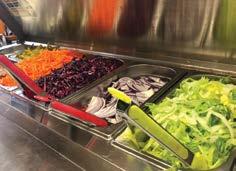
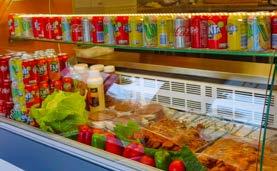



stew, with wholesome brown rice and vegetables. Or, if you’d like to try some of São Paulo’s legendary vegan fusion food, you must head to Sushimar Vegano to try Japanese Brazilian sushi.

India has a very long history of vegetarianism. Many of its religions - including Hinduism and Jainismadvocate a vegetarian diet. Within that, there are plenty of vegan options available (such as lentil deal, chana masala and vegetable biryani), and these should be dearly marked on menus. If not, don’t be afraid to ask the restaurant staff, who will be understanding of your dietary needs. If you’re looking for a quick fix, look no further than India’s incredible street food, or even have your lunch delivered in a tiffin as busy Delhi workers do, While North Indian food has some incredible veggie options. South Indian food is arguably even better for vegans, so be sure to try that too.

Brush up on your French, you’re going to Montreal.
The Québécois city is one of the most culturally rich cities in all Canada, but its youthful vibe will keep you enthralled. In Montreal, food from around the world meets in the lovely city centre - you can try Vietnamese Pho, vegan falafel pittas, and dairy-free creamy Italian pasta within walking distance of each other. But the first thing you must eat on any trip to Canada is a veganised replication of the national dish, Poutine - which is French Fries, cheese curds, and gravy. Sounds like a weird combination, but trust us - you won’t be able to get enough of Montreal’s legendary vegan versions.
Bali is visited by millions of international tourists every year, for

its beaches, jungles, and incredible history. This international flavour means it’s great for vegans, but many of Bali’s Buddhist and Hindu locals also practise vegetarianism. So, once you’ve finished exploring an ancient temple, or doing a relaxing yoga class, you’ll find plenty of options for your dinner. Besides raw burgers, piping hot tofu stir fries and spicy curries, you’ll find sumptuous vegan ice creams and cheesecakes to have for afters. If you’re there in October, be sure to attend the annual Bali Vegan Festival, where you can share some gorgeous street food with other vegan travellers.
The Antipodean nation of New Zealand is known across the world for its beautiful scenery, friendly
people, and liberal outlook. Tauranga, a small city on the Bay of Plenty, is a gorgeous place surrounded by the blue waters of the South Pacific. Not only that, it’s great for vegans - you’ll find plenty of plant-based restaurants, coffee shops and takeaways in the Harbourside part of town. Enjoy a vegan wrap as the sun sets over the water, or a healthy smoothie in the shade of Mount Maunganui.

Brazil’s super-modern financial hub definitely keeps up to date with food trends. In such a cosmopolitan city, inhabited by people from as far away as Italy, Japan, and the Arab world, you’re bound to find something that tickles your tastebuds. Savour a plate of warm, classically Brazilian black bean
Rastafarians believe humans are rai vegetarians, and some follow a vegan diet. You’ll find plenty of healthy and delicious options here check out the plantain and vegetable stews on offer.
Singapore’s melting pot of cultures - Tamil, Malay and Chinese - means its food is as diverse as its peoole. There’s vegetarian South Indian fare everywhere, and you must try the Loving Hut for a completely vegan Chinese experience

You won’t struggle to find vegan food in Berlin. More or less every eatery will have at least one vegan option, and there’s no shortage of purely vegan cafes and restaurants, either.
There’s so much more to Jordan than the classic hummus, but it’s a very good place to start. Many restaurants nowadays offer vegan options. such as grilled aubergine, and even delicious vegan burgers.
Though Greece wasn’t really known for vegan food the last five years have seen Athens transform into a vegan-friendly destination. Head over to Lime Bistro in Thiseio to enjoy vegan takes on traditional dishes.

Though the world is waking up to veganism, some places are definitely easier for veggies and vegans to enjoy than others...

One of my favourite countries in the world has to be Canada, it offers something for everyone. Western Canada with it awesome Rocky mountains offering fabulous skiing in the winter and the most stunning scenery & wildlife in the summer.

Summertime Calgary hosts the most amazing show in the World the Calgary Stampede if you can incorporate this into you visit you will have a ball. Don your Stetson & become a cowboy for your visit joining in with the fun. Vancouver is an amazing city, parks, beach museum ’s and the historical Gastown, did you know Gassy Jack hailed from our city of Hull? Whilst in this area it is definitely worth a visit to Vancouver Island the home of the wonderful Buchart Gardens.
Closer to home is the East Coast and wonderful cities ideal for a break instead of New York. Try Toronto & Niagara, Montreal & Quebec. Eastern Canada is renowned for its colours in fall and the St Lawrence river for whale watching. There are many ways to discover this fascinating country personally a guided tour gives a great experience but self drive & train travel are popular ways to explore on your own. This is also where cruising comes into play, you can sail all over the world but Vancouver is a great gateway to Alaska & the Eastern Seaboard allows you to explore much of Eastern Canada usually from Boston culminating in Quebec or Montreal.
One of my ultimate experiences in Canada was way up North in Churchill Manitoba with the Polar Bears. It is a unique experience available to view every October. Travelling in Tundra buggies you can get really close to the bears as they head out onto the ice for the winter months.

Cyprus is popular year round from the UK with people of all ages. In the summer youngsters like to hit the busy resorts whilst in the winter older visitors often stay for a little longer for 3 or 4 weeks. The island has been split for many years into the Greek South & the Turkish North. I am pleased to say the border is now open allowing much easier access to the North of the Island. Flying in to Paphos there are nice flight times from Leeds Bradford airport and you can enjoy a super 7 night Escorted tour taking in many places of interest. Much has not changed over the years, it is an area that has intrigued me since I looked over from the viewing point in Nicosia on the Greek side back in 1994. I look forward to visiting next spring to solve my curiosity.
Popular year round the Canary Islands do not need much introduction, usually more expensive to visit in the winter than in the summer when sunshine is readily available closer to home for a beach holiday. There are beautiful 5 star hotels to budget self catering properties in lively and lesser known areas, something to suit everyone ’s taste.
Las Palmas on Grand Canaria although the island capital is also a great spot to stay it has a lovely beach and also you can watch the activity of the local fishermen.

It is time to get travelling, a change is definitely as good as a rest and I would recommend a break as a great tonic. There are so many options available to travel around our wonderful world including the UK. We look forward to the opportunity of sending you away and creating wonderful memories for you to treasure in 2023 & beyond.
For all your travel needs
We are a full travel agency we book ALL tour Operators & Cruise Lines. You don’t pay extra, our advice & service is included whilst you sit back and look forward to your holiday.
09 April - Luxury River Cruise £2170

7 nights all inclusive:- pick up from your door + 2 nights via P&O North Sea Ferries.
05 May - A Taste of Scotland 5 days
Close to Loch Lomond enjoy the finer things in life relaxation, super walks or sitting back and drinking in the scenery. £595
23 May 23 - Seven Sea’s Splendor
9 night Regent Seven Sea’s all suite, all inclusive cruise. Sailing from Southampton. Ultra Luxury this is the ship on the TV Friday 9pm
From your door call for your special price.
14 July - A Welsh Adventure £975
7 nights a 2 centre holiday staying in 3 nights at the Min y Mor in Barmouth + 4 nights a the wonderful Tynedale in Llandudno. A superb itinerary of seaside, canals, railways & castles.
16 September - Wild West Ireland £1165

9 Days exploring the Wild Atlantic Way of Galway & County Mayo, another one of Marion’s unique adventures!
22 October - 10 night cruise from £1299
Feb bookings - Free Drinks package! Spain, Portugal & Gibraltar.
Sail with Emma aboard M/V Borealis Sailing from Liverpool - travel from your door Jersey from Humberside

Saturday’s Mid May to Mid September 2023

7 or 14 nights : Call for details
Free nights : DBB for B&B offers due to finish Ask about Guernsey too!
For more departures in 2023 & 2024 visit our website

Nort her n Lights Adve ntures 2024 21 January 5 days from Humberside
Full board, Thermal suits & boots
Snowmobile safari, Husky mushing, Reindeer camp & more … £1109 pp
REMEMBER we are a FULL Travel agency & book all package holidays
Plus we tailor any holiday of your choice. E.g. Canada, USA, Australia, New Zealand Escorted touring, self drive, trains etc to suit your requirements.


Scalp health is a hot topic these days – and rightly so, seeing as the length and look of your hair depend on it. To ensure you give your scalp the care and attention it deserves, we asked a local trichologist to explain what you should be doing and why...
“We know what it takes to leave our faces looking and feeling fresh, nourished and healthy. Our scalps are no different, yet they’re often neglected. Adding a simple scalp scrub to your routine can change all that. Like the skin on your face, your scalp benefits from gentle weekly exfoliation. Exfoliating masks help to remove dead skin cells and flakes, and can improve the overall health of your scalp. Over time, regular use will reduce and calm conditions such as dryness, dandruff, excessive oiliness or irritation.”
“The scalp, put simply, is the root of all hair health. It also ages six times faster than anywhere else, so it’s important to treat it with lots of care. In my opinion, prioritising scalp health is the first step to getting the rest of your hair to thrive. Whether you’re looking to strengthen strands, reduce fallout or treat conditions like psoriasis and dandruff, you need to start with your scalp. Taking care of it and prioritising a proper routine will give you a head start and ensure you maintain the right results. It’s also the answer to accelerating better hair growth.”
“How often you apply a scrub depends on the condition of your scalp, but once a week is a good


rule of thumb. If your scalp is flaky or itchy, or you have a sore or dehydrated scalp, use a targeted scalp mask twice a week until symptoms clear up. Otherwise, once weekly is enough. In terms of how to use a mask, apply it in one-inch partings from ear to ear. Massage the mask into your scalp for a couple of minutes, using firm yet gentle pressure. Roughly rubbing your scalp can irritate it and you may also end up tangling or breaking strands. Read the directions to check how long to leave your mask on for – generally, this is around ten to 20 minutes.”
“A chemical exfoliant is a great addition to your hair routine. It may sound intense, try Act+Acre Scalp Renew which is ideal as it uses just 0.15% salicylic acid to exfoliate and remove build-up, while calming any scalp irritation. Yes, it improves the health of your scalp, but it also improves the efficacy of any shampoos and conditioners you use afterwards as they can penetrate the shaft better.”
“Finding the right formula for your scalp is key. If you don’t have specific concerns, any exfoliating mask will work – just avoid sulfates and silicones which can clog follicles and strip your scalp of good bacteria. If you suffer with soreness and dryness, try hydrating scalp masks instead. Look for ones that contain ingredients like aloe vera and olive oil, as these will moisturise the scalp while getting rid of
any build-up. If you suffer with flakiness and itchiness, anti-fungal ingredients are key, including salicylic and lactic acid. Green tea extract is also useful for keeping flakes at bay.”
“If your scalp is on the drier side, it’s possible to over-exfoliate, so go carefully. In this instance, I’d recommend exfoliating on a bi-weekly basis. Look for formulas that contain hydrating ingredients, like fruit extracts, to rebalance the microbiome on your scalp. Additionally, if you’re struggling with ongoing dryness and irritation, try adding a hydrating serum to your routine. There are plenty out there that will hydrate your scalp and balance the skin barrier. You can also use nutrient-rich shampoos to bolster the hydration within your scalp.”
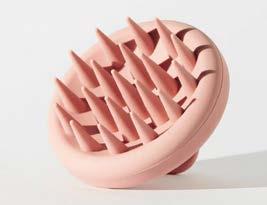

ALL HAIR HEALTH. It also ages six times faster than anywhere else, so it’s important to treat it with lots of care.
“Once a week, pre-shower, use a gentle exfoliating treatment on dry hair to break down oil and remove product build-up. Then, once you’re in the shower, cleanse with a sulfate-free and syntheticfree shampoo – use this all over your scalp, starting at the base of your neck towards your hairline.
Once rinsed out, repeat the process again. The first wash removes buildup, the second works specifically on the scalp. After you’ve done this, condition the hair with a moisturerich conditioner that boosts hydration, or use a mask that’s full of protein to boost shine. If you want to accelerate hair growth, I recommend using a dermaroller on a freshly washed scalp. The needles create micro-channels on the scalp to stimulate blood flow to the hair follicle and release growth factors. Finish off with a hair serum if needed.”
“Maintaining a healthy scalp doesn’t start or stop with the products you use. You need to have a balanced diet and increase your water intake. Diet and water are so important for healthy hair growth. Eat foods rich in protein, selenium and biotin. If you’re going to use supplements, look for ones that contain vitamins rich in plant extracts and amino acids. Likewise, it’s worth increasing your collagen intake as this supports better elastin both in the skin and hair.”
“Add a scalp massage to your routine. You can do this with your fingers and knuckles or a dedicated brush. Just as facial massage is good for stimulating skin and blood flow, your scalp can reap the same benefits.”










Is it me, or perhaps a sign of these inflationary times, but cheap new cars don’t sound particularly cheap any more. Take the Dacia Sandero, which fights hard to maintain its title of Britain’s cheapest car. Sign up for one today and the asking price will be just a fiver under £13,000.
A few months ago you would have been quoted at least £400 less; go back two years and the starting price was just £7,995. What’s also changed with the march of time is quality - thankfully also on an upward trajectory path, too.
The Romanian car manufacturer, owned by Renault since 1999, has established a strong foothold in the market since it sold its first model here in 2013 - an earlier iteration of the Sandero was first registered to a UK owner in January 2013, when prices started at £5,995.
Since then a total of 240,010 Dacias have been sold in Britain with the brand now commanding more than three per cent of the UK car market. The range has been continually upgraded but remains relatively small, with the Sandero (and its more rugged Stepway sibling) co-existing with the Dacia Duster SUV as the only choice - that is, until the innovative Dacia Jogger seven-seater jogged on to the scene last April and was joined last month by a hybrid version.
Given my opening statement about prices, you’ll perhaps not be surprised to learn the range starts
at £17,145 on the road, while the Jogger Hybrid 140 will set you back a comparatively eye-watering £22,595. But you are getting an incredibly versatile vehicle which still cleaves to the idea of low prices, even if our definition of “low” has changed somewhat.
The three-trim range starts with the Jogger Essential, followed by the Expression and tops out with the Extreme SE. All three are powered by Dacia’s new TCe 108bhp 1.0-litre three-cylinder direct injection turbocharged petrol engine, mated to a six-speed manual
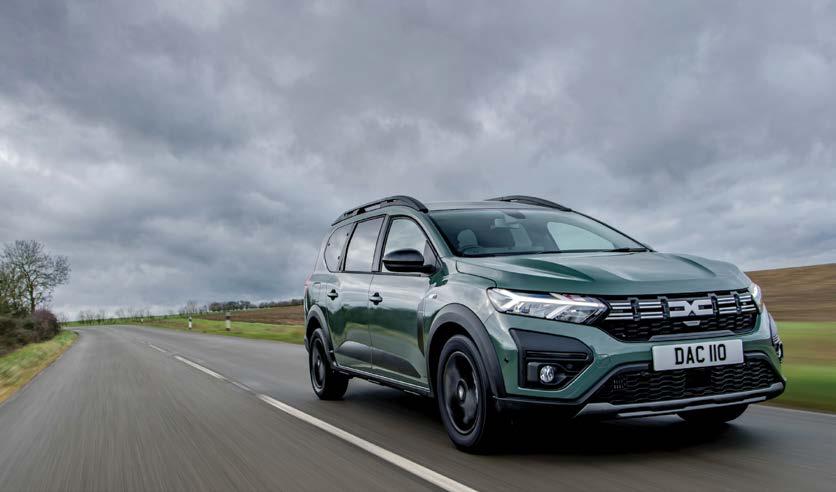
gearbox; although the two higher grades can be ordered as hybrids, featuring a 1.6-litre, four cylinder, petrol engine mated to two electric motors.
The Jogger Essential has decent equipment levels at this price

Celebrating a decade on UK roads, the still hard-to-pronounce Dacia range has been extended with a new seven-seat model; now also available as a petrolelectric hybrid. Roy Woodcock reports . . .
point, including manual air conditioning, cruise control with speed limiter, rear parking sensors, DAB radio, an adjustable steering wheel, automatic headlights, front fog lights, electric front windows, Automatic Emergency Braking System and Dacia’s Media Control that makes your smartphone responsible for the infotainment experience.
For £18,445 you get the Jogger Essential model (confusingly known as Comfort when first introduced) which adds modular roof rails, body-colour door handles, electrically adjustable and heated door mirrors with dark metal finish, automatic wipers, rear parking sensors with reversing camera, auto air-con, and 16-inch ‘Flex’ steel wheels that look like alloys but are more affordable and so help keep the price down.
Inside the Comfort model gets more equipment with a soft-feel steering wheel, satin chrome interior door handles, satin chrome and copper orange air vents, central armrest with storage, electric rear windows, electric parking brake, keyless entry, automatic air conditioning, blind spot warning, and Dacia’s 8-inch
Media Display system with two USB ports and Apple CarPlay and Android Auto.
Extreme SE models start from £19,245 and introduce 16-inch alloy wheels in a black finish, black roof bars and door mirrors, plus additional exterior styling elements unique to the model. The interior,

meanwhile, gains heated front seats, special floor and cargo mats, and Dacia’s Media Nav system with built-in navigation and wireless smartphone mirroring.

The strength of the Jogger is its versatility: You can use the car as a full seven-seater or collapse the third row of seats to turn it into a large estate car or go for massive space by just leaving the front row seats upright. With all seats in place, the boot still offers a useful 213-litres of storage space, rising to 712-litres with the third-row seats folded.
Folding the second-row seats and removing the third row increases that to a staggering 1,819 litres. It may look a little quirky but the Jogger is not ugly and is much lighter than any other seven-seater and is certainly better to drive than


most of the van-based opposition. The 1.0-litre petrol engine which gives surprisingly strong performance and the car cruises easily at motorway speed. With seven inside it will obviously take a hit but a hybrid model does provide much more punch.
Clearly it is built to a price but you could spend double this money and not get this much space or equipment and in the current climate this family and lifestyle vehicle may be the most relevant product on the road.
Dacia, I have to say, is a car name people still struggle with (literally!)it’s pronounced Datch-Yer - but that shouldn’t prevent you summoning up the coverage to visit a dealer to check one out.

More information: www.dacia.




is still work In progress. Oscar is still one of the divisions top scorers but the majority came back in August and he is really just a goalpoacher. If he gets the service in the air and chances around the penalty box he will put some away but for many games he’s just left isolated with barely one half chance a game.
Alas this has faded away not least Connolly being added to the injury list in the next game and a lack of threat until Benjamin Tetteh (top right) started his first games as centre forward an Friday night against West Brom. We had hopes that maybe they could possibly step up a gear towards the end of the season but this wasn’t to be and now its just the challenge of finishing in the top ten as the club builds for next season.
If Liam Rosenior (pic right) was in charge during the summer then things may have been much different. It took a while to bring some order to the chaos within this side before Christmas and since then the clubs form is within the top eight in the division. Apparently City now have one of the tightest defences in the Championship whereas it was the worst until October though the attacking side

He is not likely to create anything on his own but our creative play has been much lacking for most of the season. City have so many players of potential on paper but due to injuries we have yet to really see if they can come good in English football. Sinak was a £4 million winger and he’s gone back home to Turkey, Pelkas is on big wages but has made a fleeting impression when he has been fit, Allahyar looked good last April and in August and he has been injured and we are only now going to see Traore after signing him nine months ago. All of these players were signed from Turkish football and we are yet to really see a massive impact. Would they have been signed if we had the
current manager in charge as he has brought in players who have performed in the Championship and Premier League.
Ozan Tufan is becoming more of a regular now but has he really justified £3 million and big wages. He’s getting fitter than he was initially but does the hype outdo his actually weekly contributions. One player who has made an impression in his fleeting appearances is Benjamin Tetteh. He fed Oscar opportunities back in August, then got injured and suspended and he is only now back in the team. He does appear to offer much more as a centre forward as he can bring others into the game, is more mobile and decent in the air. His goalscoring record has not been great so far in his career so he may not score as many as Estupinian but he may be able to create a partnership with him or Aaron Connolly towards the end of the season.

The remainder of this season is about building for next season and if the majority of players are fit by the end of March, seeing if they do
look the part or should the club look at other options not least many of the bigger name signing are on over £20,000 a week. Are there better options elsewhere or do the attacking players really look a threat. Hull City do not look like conceding or losing many games at the moment but do they possess the players to create chances and win games and ultimately promotion next season. Already it looks likely that Jacob Greaves may be sacrificed in the summer to fund rebuilding as Premier League clubs are hovering around him just like a years ago when Keane Lewis Potter was flavour of he month to the national media.
As if all of this wasn’t enough there are two other big stories off the field. Acun is linked with a number of clubs in the Republic of Ireland with the aim of finding a club to send our young players, sign young Irish talent and to develop signings from abroad such as the young Peruvian signed in January. The idea of being a ‘feeder club’ didn’t go down a storm at Dundalk however and they have rejected the idea through supporter hostility. Saying that how would City fans react if they felt we were to be a feeder club to someone like Fenerbahce?
There is scope for funding and developing relationships but publicly suggesting they will play like us touched a raw nerve. We’ll see how this develops with Dublin club Shelbourn being the latest club linked with us. Added to this is West Park development part 3. City, Hull FC and the council all wish to develop a £25 million Sports village training centre at West Park. However this once again bring that hot potato of Hull Fair and if and where you can move it. A week long event shouldn’t prevent this investment by our owners and at least the Council are open to the idea of this and developing the stadium through a new long-term lease. Both of these initiatives will run and run however.

A month ago Hull City fans had a growing optimism that the club may be able to push for a play-off position. Successive home wins had taken them to just four points beyond the top six and the arrival of Aaron Connolly brought a new potency to the front line.



Pollinator-friendly plants will encourage an abundance of wildlife into your garden. Wild bees and insects have been in decline for decades but the good news is we can all do something to turn this around. Our gardens, however large or small, can become wildlife havens and provide essential green corridors in urban areas.
Select plants high in pollen and nectar; some are more suitable for pollinators than others. Single flower heads give insects easy access to their valuable fuel, whereas doubles are bad news as they may look pretty but the petals hinder access and the blooms are often sterile, offering little in nourishment and simply wasting the pollinator’s energy.
The list of pollinator-friendly plants is vast; hellebores, lavender, sedum, sunflowers and teasels, crab apples, chives, mahonia, single dahlias, echinacea, pulmonaria, rudbeckia, zinnia and flowering herbs are all excellent choices. From earlyflowering spring bulbs to summer salvias, autumn asters to winter willows; select any combination of these plants and give pollinators a boost. Don’t forget moths; they feed at night so grow some nightscented blooms, too.

Tubular flowers such as foxgloves, comfrey, borage and buddleia particularly suit long-tongued bees and butterflies’ proboscises. A vital lifeline to help pollinators is to stop using chemicals in the
garden. Check any bought plants and seeds are free from pesticide residues - buy organic to be really sure.
It seems to be the buzzword of the moment, but it’s also problematic, especially when it gets used in relation to gardens.
When it comes to the ‘Big Picture’ - that is, our global environment and wildlife - rewilding is a sound and progressive concept.
Defined as ‘restoring an area of land to its uncultivated state, conservationists are looking to reintroduce endangered species to African plains, reforest over-farmed land and bring back key carnivores and herbivores long since hunted by humans to keep the ecological balance in check.
This is just as it should be, and if accomplished - to mitigate climate change and halt environmental destruction - the future looks bright.
On a smaller scale, though, ‘Rewilding gets used a lot now in advice on how we should garden. Off-putting, isn’t it? This turn of phrase can seem daunting, a dispiriting hint that we need to leave our gardens to go wild and messy. It must also worry people that they’re not gardening right.
Well, for me the notion raises unrealistic expectations and is extremely misleading.
What we need is a clear and accurate definition of what people mean when they say ‘rewilding. ‘Restoring a garden to its uncultivated state’ to bring back environmental balance is not ecologically sound advice and won’t be of huge benefit to wildlife. It’s not what will happen - instead a small number of species will simply take over rapidly, lessening the biodiversity, and your plot will be all the poorer for it.
Gardens, by their very definition, aren’t wild. They are and always have been carefully managed, controlled spaces; they’re astoundingly biodiverse just as they are and have become successful, vital conservation areas because of it. Because we curate and cram so much into such small spaces - ponds, trees, grass, flower borders, rockeries - our gardens are their own tightly-packed little ecosystems, buzzing with life, mimicking a huge range of wild habitats. Real wildlife gardening is about adding on beneficial extras to your already very biodiverse, ordinary gardens. This is a lot better, quicker, more idealistic and sustainable than simply letting everything go wild. So, ‘rewilding’ should just be taken as a loose term, meaning to change your mind set a little, let nature in, plant plenty of open flowers and greenery and reduce chemical use So don’t put down your trowel and snips just yet!
Grow plants in a sunny, sheltered spot. Group plants together so insects can move easily from flower to flower.
Pollinators are attracted to single, cup-shaped, clustered and tubular
flowers in a range of colours. Sow a wildflower border. A mix of cornflowers, poppies, ox-eye daisies, calendula and grasses are great for pollinators.

Various bees, moths and butterflies, hoverflies, wasps and beetles all help to pollinate plants.
Plants in the border get most of their nutrients from the soil. If you look after your soil, mulch and choose the best plants for your site, you shouldn’t need to feed most shrubs. But a spring application of fertiliser will boost growth and flowers. Organic fertilisers are best because they release their nutrients slowly. Fish, blood and bone is good for most plants or use chicken pellets. Sprinkle the fertiliser around the base of the shrubs. You can add a second dressing in early summer if required.
Over winter lawn edges can become overgrown, so give your garden a spring clean on a dry, mild day and smarten them up. A halfmoon edging tool is ideal for re-establishing edges along paths and borders. Insert the blade where the lawn and path meet, then gently rock the tool back and forth to cut the edge back in. Pull back the excess grass to reveal a straight edge. Alternatively give lawn edges a haircut with long- handled cutters. Remove grass cuttings for a neat finish; these can be placed on the compost heap.
Homegrown sweet peas are a joy,
Well thought-out planting choices will see your plot teeming with useful bees and other insects
but these keen growers are prone to bolting and can quickly become tall and leggy, particularly when sown indoors over winter. Promote bushy seedlings by pinching out the tips once you have two pairs of true leaves. Simply take the growing tip between your thumb and forefinger and nip out the top or cut with snips. This will encourage the stem to produce side shoots, making a stockier plant, and in the long run should produce more flowering stems. If possible, move your seedlings to a cold frame to slow growth down.
It’s important to thin carrots so the roots have enough space to grow. Once the plants are around 10cm tall, remove weaker seedlings, leaving a 2-4cm space around remaining ones. Gently pull out the whole plant; be careful not to crush the foliage as the smell attracts carrot fly. If you don’t want to waste any seedlings, transplant them in a new row and water them in well. To protect your crop from carrot root fly, cover it with horticultural fleece.
You can harvest cabbages throughout the year, but the easiest and quickest to grow are summer and autumn varieties. These can be sown until May and include round and pointed cabbages, such as popular ‘Hispi’ and ‘Greyhound’ types. They grow quickly in summer, so sow a few seeds every month for a staggered harvest. Sow a few seeds in a pot and grow on seedlings in small pots or cell trays ready to plant out later. Sown now, seedlings can be planted out in mid-April and be ready to harvest in July.

• FREE ERECTION
• FREE LOCK AND KEY
• ANY SIZE AVAILABLE
• BASE LAYING
OPENING TIMES:
Tuesday to Saturday: 8:30am - 5pm
Sundays (& Bank Hols): 10am - 4pm
Closed Mondays
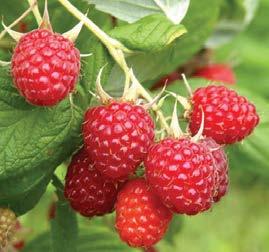
Autumn raspberries produce flowers and fruit at the top of stems that start to grow the same spring. This makes pruning simple - all stems are pruned down to the base in winter before new growth starts. After pruning, apply a general fertiliser and a mulch of organic matter to feed new growth and help retain moisture in summer. Raspberries spread by suckers so you may need to dig up shoots appearing too far from the main clumps of stems. Thinning out the stems also helps prevent overcrowding and will result in more vigorous growth of the remaining canes.
SUMMER HOUSES
PLAYHOUSES
GARAGES
KENNELS
POTTING SHEDS


FENCE PANELS
FENCE ERECTING
VISIT OUR SHOW SITE
SHARPS WORLD OF WOOD
THE LOG CABIN, YORK ROAD, BARMBY MOOR, YORK
YO42 4HS - Near Pocklington
www.sharpsworldofwood.com

CALL NOW - 01759 30 55 66






People always think that Lent is just about giving something up – like chocolate, smoking or alcohol - and yes, if that’s what you want to do, that’s brilliant. But it can also be a time for doing something positive, something that can make a real difference to someone else’s life. You might spend more time with a sick or elderly relative or neighbour or spend some proper quality time with your children. Maybe do a good deed every day. You don’t have to tell anyone what you’re doing, just keep it to yourself. This Lent, though, I have also decided to take part in CAFOD’s Big Lent Walk to help fight global poverty, so, along with hundreds (possibly thousands) of people, I’ll be walking 200km (125 miles) over 40 days and we’ll be fundraising throughout. It works out at just over 3 miles a day. Whatever you decide to do, good luck!
Why can’t we go back to A, B, C?
I know I’m not the only parent that gets confused by the way GCSEs are graded now from 1 to 9, 1 being the lowest and 9 being the highest. And I know this has been the case for a few years now (but it’s only more recently affected me!) The thing is, we all ask the teachers what letter grade each one means. So, 7 is an A, 8 is an A* and 9 is an A**. (Don’t get me started on all the stars! I really can’t see the point of them!) Anyway, a 6 is a B, a 5 is a low B/high C and a 4 is a C. At least, this is how it was explained to me. I assume 3-1 means D-F. The thing is, because there are so many numbers, my daughter told me that she and her friends (and most of their year) feel that if they get below a 7 they’re not doing very well, because that’s already 3 numbers down from the top grade. She feels better after I’ve explained what everything means, but even they think A-C grades are more straightforward. Is it just us? I can’t believe that. Anyway, we’ve got GCSEs and A Levels in our house this year. Yay! At least they go back to letter grades for A Levels!
With everything in the news about vegetable shortages, I really want to make an extra effort this year to grow my own vegetables and salad. I’ve never done it before, but I’m prepared to do my research and learn. If anyone has any tips for easy things to get started with, I’m all ears!! I’m thinking carrots, salad leaves, tomatoes, courgettes and beetroot! Fresh is best, after all! And if you don’t want to grow your own, check out your local suppliers. Supermarket fruit and veg is so disappointing these days and goes off so quickly (I had some strawberries recently that went mouldy in the fridge 3 days before the sell by date!). Ooh, strawberries – I need to add those to my list of things to grow!)
And finally, a Happy St. David’s Day on the 1st March to all you lovely Welsh people –and a Happy St. Patrick’s Day on the 17th to my fellow Irishmen and women.
Have a brilliant March everyone!

Fiona x
Twitter: @fionadwyer • Facebook: Fiona Dwyer PR
One good thing about music, when it hits you, you feel no pain. - Bob Marley
QUALITY BEDROOM MAKEOVERS BY LOCAL PROFESSIONALS
› Bespoke sliding wardrobes
› Styles to suit every home
› Wide range of colours and finishes to choose from dreamdoorsbedrooms.co.uk

› Up to 50% less than a new fully fitted kitchen
› From simple door replacements to complete fitted kitchens
› Fully installed by local professionals in just a few days

› Choose from a large selection of doors, worktops and appliances dreamdoors.co.uk

